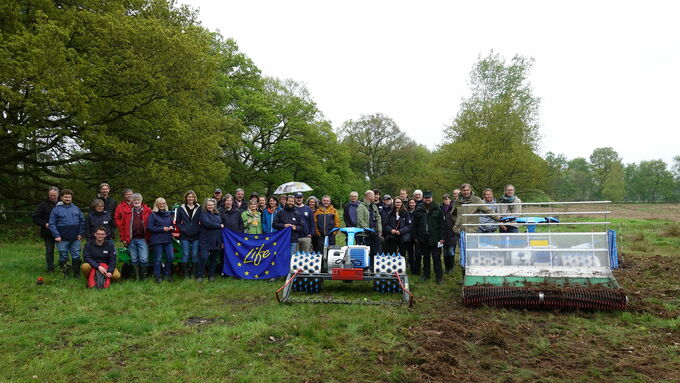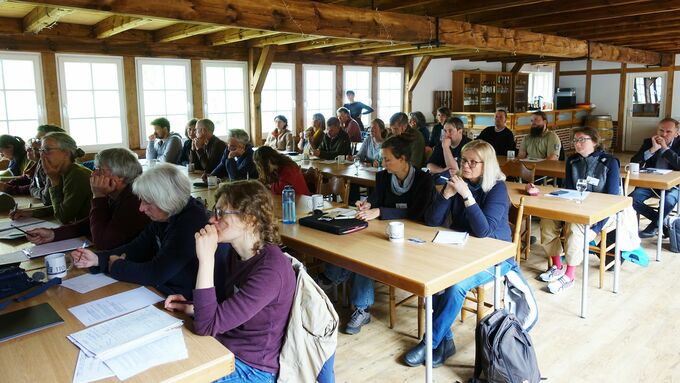The excursion group with the demonstrated insect-friendly sickle bar mower © company ‘Urbane Vielfalt´
download picturemain content
Project of the month
#5/2023 EXPERT EXCHANGE IN THE LÜNEBURG HEATH
How can we save the species-rich Nardus grasslands?
Almost 40 participants, mainly from nature conservation institutions from different regions of Lower Saxony and nine top-class speakers, some of whom had travelled from Luxembourg, the Netherlands and the Black Forest: The LIFE IP team at the NLWKN had gathered all the important stakeholders for the topic ‘Atlantic Nardus grasslands’ for a two-day expert exchange. The focus of the event was on knowledge transfer, knowledge gain and networking.
The programme of this professional exchange was well filled and varied: The first day started in a cosy atmosphere in the conference room of the ‘Haverbeckhof’ near Bispingen with an introduction to the topic. The situation and threats to the sensitive habitat type were presented and Lower Saxony's responsibility within the Atlantic region was made clear. Important aspects of the following lectures were the nutrient cycles, soil parameters as well as the restoration and management of sites. Furthermore, there was a short digression into the population biology of the endangered plant species of the Nardus grasslands. The lecture block ended with a short workshop in small groups in which experiences were exchanged and possible solutions regarding initial restoration and management were discussed.
After dinner, the ‘Verein Naturschutzpark Lüneburger Heide’ (Association for the Nature Conservation Park Lüneburg Heath) offered a short excursion to an area of Nardus grassland near Camp Reinsehlen. The former military area has a complex past and today's areas are just as diverse with their transitions from dry heaths, sandy grasslands and Nardus grasslands and the associated questions about management. After looking at different parts of the site, a few small individuals of common moonwort (Botrychium lunaria) were discovered in the last sunlight.
On the second day, the participants were given a lecture on the funding possibilities for management and development measures. After a short theoretical introduction to the excursion areas, the participants went out into the field to visit the areas. The first stop was the nature reserve ‘Borstgrasrasen bei Badenstedt (Nardus grasslands near Badenstedt) in the district of Rotenburg (Wümme). This SAC is a fine example of a Nardus grassland which is being developed again in a good direction through initial restoration in cooperation with the local ecological station. The measures mainly comprised restoration grazing financed by the LIFE IP (two two-week passes per year over three years) as well as woodwork. Here, the group could marvel at the flowers of the heath violet (Viola canina) and also see that excessive ploughing is not a suitable method for the development of Nardus grasslands, as the mineral soil should not be exposed.
The next stop was in the district of Verden near Quelkhorn. Here, only small remnants of Nardus grasslands were still present, but something special was waiting for the excursion group: a machine demonstration of a gentle and insect-friendly sickle bar mower which can be used well on uneven terrain. The company also presented various other attachments such as a demosser.
Finally, the LIFE IP team had selected a particularly well-developed area of Nardus grassland (conservation grade A), also in the district of Verden. The spring slope has a mosaic of different habitat types and areas of Nardus grassland. The participants discovered many rare species, including the common lousewort (Pedicularis sylvatica) and the already easily recognisable spotted leaves of the heath spotted orchid (Dactylorhiza maculata). This area was also ideally suited to discuss the challenges of outlining the Nardus grassland.
After two intensive and exciting days, everyone headed home with new impulses, questions and answers. The LIFE IP team would like to thank all participants and looks forward to the successful implementation of further actions for the Nardus grasslands habitat type!





